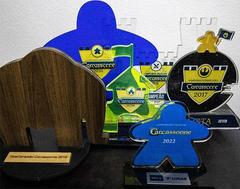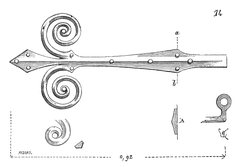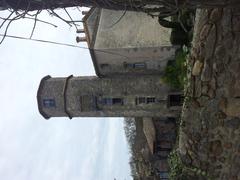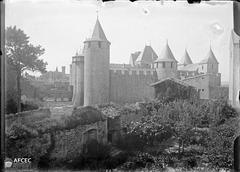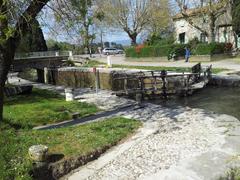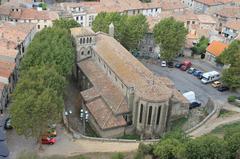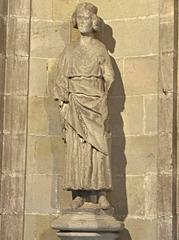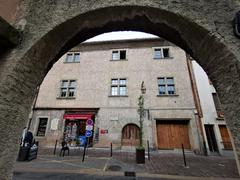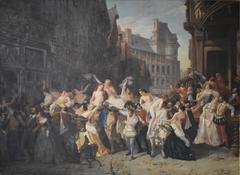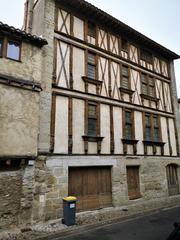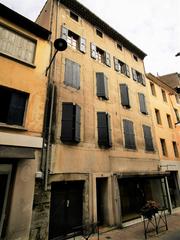
Basilica of St. Nazaire and St. Celse: Visiting Hours, Tickets, and Visitor Guide to Carcassonne’s Historical Gem
Date: 03/07/2025
Introduction
Nestled within the UNESCO-listed medieval Cité de Carcassonne, the Basilica of Saint-Nazaire and Saint-Celse stands as a testament to centuries of religious devotion, architectural innovation, and cultural heritage. Renowned for its harmonious blend of Romanesque and Gothic styles, the basilica offers an evocative journey through the spiritual and artistic legacy of southern France. Whether you are fascinated by medieval art, interested in the region’s turbulent past, or seeking a tranquil space for reflection, this guide provides comprehensive details on the basilica’s history, architecture, visiting hours, ticketing, accessibility, and practical tips for a memorable visit.
Table of Contents
- Introduction
- Historical Overview
- Architectural Features and Cultural Impact
- Visiting Information
- Practical Tips for Visitors
- Frequently Asked Questions (FAQ)
- Conclusion
- References and Further Reading
Historical Overview
Early Foundations and Origins
The roots of the Basilica of Saint-Nazaire and Saint-Celse stretch back to the early Christianization of the region. Tradition suggests the first church dedicated to Saints Nazarius and Celsus—a pair of early Christian martyrs—may have been established on the site as early as the 6th century, following the reign of Theodoric the Great (Wikipedia). The earliest documented reference dates to 925 during the tenure of Bishop Gimer, at which point the church was already serving as a central locus of worship and community (Wikipedia).
Medieval Transformations and Romanesque Construction
The basilica’s Romanesque phase began in the 11th century, solidified by the blessing of its building stones by Pope Urban II in 1096 (France-Voyage). Completed in the first half of the 12th century, the Romanesque nave and portal are characterized by robust sandstone walls, semicircular arches, and a fortress-like solidity. These elements remain a striking feature and set the foundation for later Gothic enhancements (Midi-France).
Gothic Expansion and Artistic Flourishing
The 13th and 14th centuries brought a dramatic transformation as Carcassonne came under royal control and the Gothic style flourished. After the 1209 siege during the Albigensian Crusade, the bishop obtained permission to expand the church. The choir and transept were rebuilt in the Gothic style, introducing pointed arches, ribbed vaults, and magnificent stained-glass windows (Christian Directory). This architectural juxtaposition between Romanesque and Gothic elements results in a unique visual and spiritual experience for visitors.
The basilica’s stained-glass windows, primarily from the 13th and 14th centuries, are among the oldest and most vibrant in southern France. They depict biblical scenes and saints, illuminating the interior with a kaleidoscope of color and light (BudgetYourTrip; France-Voyage).
Civic and Religious Significance
Throughout the Middle Ages, the basilica was the seat of the bishopric, hosting major liturgical celebrations, royal ceremonies, and civic events. Its role as a center for sacred music was underlined by the presence of an 18th-century organ, which is still in use today (Wikipedia). The church’s location within the fortified city made it both a spiritual and symbolic bulwark for Carcassonne’s citizens (Christian Directory).
Decline, Restoration, and Modern Status
After the French Revolution, the basilica lost its cathedral status as the seat was moved to the lower town. By the 19th century, it had fallen into disrepair. Comprehensive restoration led by Eugène Viollet-le-Duc preserved both Romanesque and Gothic features and rescued the basilica from ruin (Wikipedia). In 1898, Pope Leo XIII elevated the church to the rank of minor basilica, recognizing its spiritual and artistic importance (Christian Directory).
Architectural Features and Cultural Impact
Romanesque and Gothic Harmony
The basilica’s architecture is a masterful blend of Romanesque and Gothic elements. The Romanesque nave is marked by massive columns, rounded arches, and a subdued, intimate atmosphere. The transition to the Gothic choir and transept is dramatic—soaring vaults, pointed arches, and expansive stained glass create a luminous, vertical space (Midi-France; Spotting History).
Stained Glass and Sculptural Details
The basilica’s stained-glass windows are celebrated for their age, artistry, and vivid narrative scenes. The rose window in the western façade and the choir’s medallion windows are especially prized (France-Voyage). Sculptural elements such as carved capitals, archivolts, and gargoyles enrich both the interior and exterior, reflecting the imagination and skill of medieval artisans (Grand Carcassonne Tourisme).
Cultural and Spiritual Role
The basilica remains an active site of worship, a venue for concerts and cultural events, and a symbol of Carcassonne’s enduring identity. It is affectionately known as “The Jewel of the City” for its architectural and artistic grandeur (Christian Directory; French Moments).
Visiting Information
Hours, Tickets, and Admission
- Opening Hours: Typically open daily from 9:00 AM to 6:00 PM, with possible variations during holidays and special events. Check the official Carcassonne tourism website for current information.
- Admission: Entry to the basilica is free. Some guided tours or special exhibitions may require a ticket (frenchmoments.eu).
- Guided Tours: Tours in multiple languages are available and highly recommended for deeper insights. Book in advance during peak tourist seasons (veronikasadventure.com).
Accessibility
- The basilica is generally accessible, with ramps and assistance for visitors with mobility challenges. Some medieval areas may have steps or uneven surfaces; contact the Cité’s visitor center for detailed accessibility information.
Special Events
- The basilica hosts concerts, particularly featuring its historic organ, and special cultural or religious events throughout the year. Check local listings or the basilica’s notice board for schedules.
Nearby Attractions
- Château Comtal: The medieval castle offers panoramic views and museum exhibits.
- City Walls: Walk the ramparts for impressive city and countryside vistas.
- Local Eats: Sample regional cuisine at nearby cafés and restaurants (bonadvisor.com).
Practical Tips for Visitors
- Best Times to Visit: Early morning or late afternoon for a peaceful experience and optimal lighting for photography.
- Dress and Conduct: Modest dress is appropriate; maintain a respectful demeanor, especially during services.
- Photography: Permitted, but avoid flash and disruptive equipment. Be discreet during religious ceremonies.
- Amenities: Restrooms and shops are available in the Cité, but not inside the basilica itself.
- Length of Visit: Allow at least 30–45 minutes to appreciate the basilica’s features.
Frequently Asked Questions (FAQ)
Is admission to the basilica free?
Yes, entry is free. Special exhibitions or guided tours may have a fee.
What are the opening hours?
Generally 9:00 AM–6:00 PM, though hours may change seasonally or for events. Verify on the official tourism website.
Is the basilica wheelchair accessible?
Most of the basilica is accessible. For assistance or detailed routes, contact visitor services in advance.
Are guided tours available?
Yes, in several languages, both onsite and online booking options exist (veronikasadventure.com).
Can I take photographs inside?
Photography is allowed but please be considerate, particularly during services.
Conclusion
The Basilica of Saint-Nazaire and Saint-Celse embodies the enduring spirit and artistry of Carcassonne. Its Romanesque foundations and soaring Gothic expansions capture the city’s layered history and cultural significance. With free admission, accessibility features, and enriching guided tours, the basilica welcomes visitors from around the world to experience its splendor. Whether you seek spiritual reflection, architectural marvels, or a window into medieval life, the basilica is a highlight not to be missed in Carcassonne.
Plan your visit today, consult the official Carcassonne tourism site, and enhance your experience with the Audiala mobile app for guided tours and real-time updates.
References and Further Reading
- Basilica of Saint-Nazaire and Saint-Celse de Carcassonne, Wikipedia
- Basilica of Saint Nazaire and Saint Celse, Carcassonne, France, Christian Directory
- Basilica of Saints Nazarius and Celsus, Wikipedia
- France Voyage: Church Saint Nazaire
- Midi France: Carcassonne - Basilica of Saint Nazaire
- Budget Your Trip: Basilica of Saint Nazaire Worth Visiting
- World City Trail: Basilica Saint Nazaire Carcassonne
- Carcassonne Tourism Official Site
- Spotting History: Basilica of Saints Nazarius and Celsus
- Minube: Saint Nazaire Basilica
- French Moments: Cite of Carcassonne
- Bonadvisor: 1 Day in Carcassonne
- Grand Carcassonne Tourisme
- Veronika’s Adventure: Walking Tours in Carcassonne




